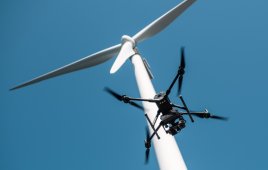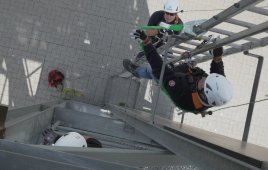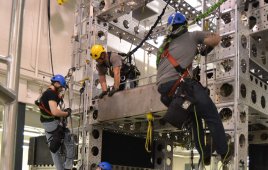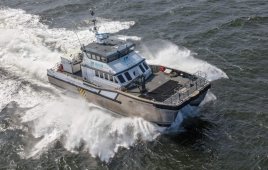Safety in wind turbines is prompted by hazardous weather, working at heights, a potential for fires in the nacelle, and working around high voltages.
From lightning: Wind turbine towers are a natural target for lightning strikes. A main lightning discharge is characterized by rapidly rising current that peaks at about 200,000 Amps and averages about 30,000A over its duration. Even though the event is over in milliseconds, there is great potential for harm to personnel and damage to equipment. Personnel working around such a hazard that often strikes wind turbines want to know that they are safe when entering a tower. Electrical grounding is the foundation for an expected level of safety and that begins with a properly designed and installed electrical grounding system.
A good grounding system plays a critical role guarding against catastrophic damage to blades, electronics, transformers, nacelles, and collector systems out to substations.
Another way to protect workers against lightning is to spot it before it gets to the wind farm. Advanced warning of real-time lightning strikes from real-time lightning data is safer than predictions that lead to false alarms or delayed reporting after lightning has struck.
For example, the Great Plains are susceptible to extreme weather conditions. Summer brings the threat of lightning strikes to the 300-ft turbines, and brutally cold temperatures are commonplace in winter.
To ensure turbines operate at peak-efficiency, most facilities have technical teams on-call around the clock to perform maintenance duties. However, standard practice is not to send team out when temperatures dip below -30°C. To know when hazardous weather approaches, maintenance managers often subscribe to services that warn of impending lightning strikes. The internet-based services let managers stay abreast of changing weather conditions that endanger operations.
For a wider view of approaching severe weather, managers can monitor radar and track storms, wind, and lightning at online weather services. Weather services often feature weather maps in layers that let personnel look at weather information most important to its operations. This includes national Weather Service warnings, watches, and advisories. Another layer includes custom areas of maximum impact based on parameters set by the forecaster to reflect how weather is affecting a turbine location.
Weather services also provide mobile alerts to current and future conditions. Subscribers receive weather information on their mobile phones. What’s more, personalized alerts can be sent to technicians’ phones when severe weather nears user-defined alerting parameters. This is useful to field technicians on maintenance tasks. For instance, they can be notified when lightning has been detected within 50 miles.
From working at height: even short towers are a long way up, 150 ft on the low side and soon 300 ft. Climbing up such heights challenges a tech’s knees and physical stamina. Climb-assists and service lifts are solutions. Climb assists are devices that connect a technician’s harness to an endless belt that runs on pulleys mounted over a tower ladder. Then a motor keeps a steady upward user-selected pull (from 50 to 125 lb) on the individual, thereby lightening his load.
Other hazards exist once a technology reaches the nacelle. According to Liberty Mutual’s 2009 Safety index, for instance, accidents from falling objects cost U.S. industry some $4.3 billion that year, the fifth leading cost of industrial accidents. This type of accident is almost completely preventable by using simple tethering devices. So when technicians reach a nacelle, they often attach retractable tethers and lanyards to tools and instruments. Such tethers come in many configurations that can be used for almost any industrial tool or application.
For more specialized applications, several manufacturers say they can produce custom devices. Safety engineers are often charged with ensuring adherence to OSHA regulation 1926.759(a), which requires “that all materials, equipment, and tools, which are not in use while aloft, must be secured against accidental displacement.” Tethers allow complying with this safety regulation.
Filed Under: Safety





In my opinion the operation problems of wind power staions caused by lightning is underestimated. Very little is being published of these problems because the information about the real life will cause problems to the marketing of new projects. I was involved in protection of windpower stations against lightning in Norway about 15 years ago and know that damages to the control systems and their electrical installations in general is extremely difficult. This in addition to the prevention of wing damages. I will really recommend you to fokus more on this problem area. I am convinced that the real maintenance and operation costs are much higher that presented today, just because the problems and costs caused by lightning are very much underestimated.
Workers should not be neighter outside nor inside the nacelle in case lightning is recognised in the neighbourhood.